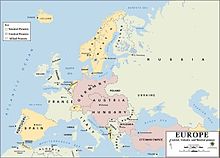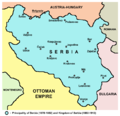This is an old revision of this page, as edited by Human Rights Believer (talk | contribs) at 10:34, 23 January 2010 (Undid revision 339512283 by Evlekis (talk). Fascist Serb nationalist). The present address (URL) is a permanent link to this revision, which may differ significantly from the current revision.
Revision as of 10:34, 23 January 2010 by Human Rights Believer (talk | contribs) (Undid revision 339512283 by Evlekis (talk). Fascist Serb nationalist)(diff) ← Previous revision | Latest revision (diff) | Newer revision → (diff)| Kingdom of SerbiaКраљевина Србија Kraljevina Srbija | |||||||||||
|---|---|---|---|---|---|---|---|---|---|---|---|
| 1882–1918 | |||||||||||
 Flag
Flag
 Coat of arms
Coat of arms
| |||||||||||
| Motto: Само слога Србина спашава Samo sloga Srbina spašava (Only Unity Saves the Serbs) | |||||||||||
| Anthem: Bože Pravde | |||||||||||
 The Kingdom of Serbia pre-WWI The Kingdom of Serbia pre-WWI | |||||||||||
| Capital | Belgrade | ||||||||||
| Official languages | Serbian | ||||||||||
| Government | Constitutional monarchy | ||||||||||
| King | |||||||||||
| • 1882–1889 | Milan Obrenović IV | ||||||||||
| • 1889–1903 | Aleksandar Obrenović | ||||||||||
| • 1903–1918 | Peter I Karađorđević | ||||||||||
| History | |||||||||||
| • Established | 6 March 1882 | ||||||||||
| • Serbian Front (WWI) | August 1914 – November 1915 | ||||||||||
| • Joined Yugoslavia | 1 December 1918 | ||||||||||
| ISO 3166 code | RS | ||||||||||
| |||||||||||
The Kingdom of Serbia (Serbian: Краљевина Србија, Kraljevina Srbija) was created when Prince Milan Obrenović, ruler of the Principality of Serbia, was crowned King in 1882. The Principality of Serbia was ruled by the Karadjordjevic dynasty from 1817 onwards (at times replaced by the Obrenovic dynasty). The Principality, suzerain to the Porte, had expelled all Ottoman troops by 1867, de facto securing its independence. The Congress of Berlin in 1878 recognized the formal independence of the Principality of Serbia.
In international affairs, The Kingdom of Serbia was the legal predecessor of Yugoslavia which was formed after World War I at the Versailles Peace Conference, 1919. Internally, however, Kingdom of Serbia had ceased to exist in 1918 when joined the former Habsburg South Slavic lands to form the Kingdom of Serbs, Croats and Slovenes under the crown of Serbian dinasty of Karađorđević. Serbia gained significant territorial expansion in the Balkan Wars and almost doubled its territory, with the areas populated mostly by the foreign population (Albanians, Macedonian Slavs, Turks and others). In Serbia, annexed territories was consider "as a dependency, a sort of conquered colony, which these conquerors might administer at their good pleasure". Newly acquired territories never fully became part of the Kingdom of Serbia. It were subjected to military dictatorship, and was not included in Serbian constitutional sistem. The opposition press demanded the rule of law for the population of the annexed territories and the extension of the constitution of the Kingdom of Serbia to these regions.
History

Principality of Serbia
Main article: Principality of SerbiaThe Principality of Serbia was a state in the Balkans that came into existence as a result of the Serbian revolution which lasted between 1804 and 1817. Despite serious and extremely brutal oppression and revenge by the Ottoman authorities, the revolutionary leaders, first Karađorđe and then Miloš Obrenović, succeeded in their goal to liberate Serbia after centuries of Turkish rule.
At first, the principality included only the territory of the former Pashaluk of Belgrade, but in 1831-1833 it expanded to the east, south, and west. In 1867 the Ottoman army was expelled from the Principality, securing its de facto independence. Serbia was further expanded to the south-east in 1878, when it won full international recognition at the Treaty of Berlin. The Principality would last until 1882 when it was raised to the level of the Kingdom of Serbia.
Serbo-Bulgarian War
Main article: Serbo-Bulgarian WarThe Serbo-Bulgarian War was a war between Serbia and Bulgaria that erupted on 14 November 1885 and lasted until 28 November the same year. The war ended in defeat for Serbia as it had failed outright to capture the Slivnitsa region which it had set out to achieve: the Bulgarians successfully repelled the Serbs after the decisive victory at the Battle of Slivnitsa and advanced into Serbian territory taking Pirot and clearing the way to Niš. When Austria-Hungary then declared that it would join the war on the side of Serbia, Bulgaria withdrew from Serbia leaving the Serbo-Bulgarian frontier precisely as it had been prior to the war. Final peace was signed on 19 February 1886 in Bucharest. As a result of the war, European powers acknowledged the act of Unification of Bulgaria which happened on 6 September 1885.
Bosnian Crisis
Main article: Bosnian CrisisThe Bosnian Crisis of 1908-1909 (also referred to as the Annexation crisis) erupted into public view when on October 5, 1908, Bulgaria declared its independence and one day later, Austria-Hungary - which had occupied Bosnia and Herzegovina since 1878 in accordance with the provisions of the Congress of Berlin - announced the annexation of Bosnia and Herzegovina, a region which was populated mainly by the Slavic nations (Serbs, Croats and Slavs of Muslim faith identifying by various demonyms). Russia, the Ottoman Empire, Britain, Italy, Serbia, Montenegro, Germany and France took an interest in these events. In April 1909, the Treaty of Berlin was amended to accept the new status quo bringing the crisis to an end. The crisis permanently damaged relations between Austria-Hungary on the one hand and Russia and Serbia on the other. The annexation and reactions to the annexation were contributing causes of World War I.
Balkan Wars and ensuing changes
Main articles: Balkan Wars and Serbian occupation of Albania
Serbia, victorious in two Balkan Wars, gained significant territorial areas of the Central Balkans and almost doubled its territory. During the Balkan Wars of 1912, most of Kosovo was taken from the Ottoman Empire by the Kingdom of Serbia while the region of Metohija (know as the Dukagjini Valley to ethnic-Albanians) was taken by the Kingdom of Montenegro. Over the centuries, populations of ethnic Serbs and Albanians tended to shift following territorial handovers. As a result of the multi-ethnic composition of Kosovo, the new administrations provoked a mixed response from the local population. Whilst Albanians did not welcome Serbian rule, the non-Albanian population in Kosovo (laregly Serb but other Slavic nations too) considered this a liberation.
After the First Balkan War of 1912, Kosovo was internationally recognised as a part of Serbia and northern Metohija as a part of Montenegro at the Treaty of London in May 1913. In 1918, Serbia became a part of the newly-formed Kingdom of Serbs, Croats and Slovenes, later named Yugoslavia. Disagreements regarding the territory of Macedonia among the members of the Balkan League led the the Second Balkan War. Here, Serbia and Greece fought against Bulgaria in 1913. Finalisations concerning which country took which parts were ratified at the Treay of Bucharest the same year. Serbia came to control the land which became known as Vardar Macedonia, which today stands independent as the Republic of Macedonia.
Assassination in Sarajevo
Main article: Assassination of Archduke Franz Ferdinand of AustriaThe assassination of Archduke Franz Ferdinand of Austria on 28 June 1914 in Sarajevo (then part of the Austro-Hungarian Empire) brought the tensions between Austria-Hungary and Serbia to a head. Behind Assassination in Sarajevo was secret radical organization, Black Hand, from Serbia. The assassins were supported by an "underground railroad" of Serbian civilians and military officers that provided transportation and hid them; and members of the Serbian military that trained them, encouraged them, and provided weapons, maps, and other information. After the assassination, the conspirators were arrested in Bosnia-Herzegovina were tried in Sarajevo in October 1914.
The political objective of the assassination was to break the Austro-Hungarian south-Slav provinces off from the Austro-Hungarian Empire. Assassination of Archduke Franz Ferdinand triggered a chain of international events that embroiled Russia and the major European powers. War broke out in Europe over the next thirty-seven days.
World War I
Main articles: Serbian Campaign (World War I), Salonika front, and Creation of Yugoslavia
Serbia won the first Allied victory of World War I in 1914. In 1915 it was occupied by foreign troops due to a combined invasion by Austro-Hungarian, German, and Bulgarian troops.
At the end of the war, Serbia went through radical changes within days. Beginning in late 1918, it absorbed the Kingdom of Montenegro at the Podgorica Assembly. It then joined forces with the previously unrecognised State of Slovenes, Croats, and Serbs to form a new Pan-Slavic state, the Kingdom of Serbs, Croats and Slovenes.. The new country continued to be ruled by the Serbian monarchy.
Rulers

During its existence, the Kingdom was ruled by two dynasties: the House of Obrenović and the House of Karađorđević. King Milan Obrenović ruled from 6 March 1882 to 6 March 1889, when he abdicated the throne. He was succeeded by his son, Aleksandar Obrenović, who ruled from 6 March 1889 to 11 June 1903, when he was deposed by a group of officers. The slaughter of the royal couple (the king and Queen Draga) by the Black Hand shocked Europe. This opened the way for the descendants of Karađorđe (Karageorge), regarded by Serbs throughout the Balkans as the man who threw off the Turkish yoke, to return to the throne. Petar Karađorđević was initially reluctant to accept the crown, disgusted as he was by the coup d'état. However, he finally did accept and was the Kingdom's sovereign from 15 June 1903 to 1 December 1918, the day that the Kingdom of Serbs, Croats and Slovenes was proclaimed.
International Relations
In a brief period between WWI and WWII the Kingdom of Yugoslavia, successor to the Kingdom of Serbia, formed a "Small Entente" loose union between Czechoslovakia, Romania and Serbia. The alliance was supported by France and dissolved in 1934 as German influence in Europe was growing.
Cities
The largest cities in the Kingdom of Serbia were (with population figures from ca. 1910-1912):
- Belgrade - 100,000
- Prizren - 60,000
- Bitola - 54,000
- Skopje - 50,000
- Niš - 25,000
- Veles - 24,000
- Priština - 20,000
- Prilep - 20,000
- Kragujevac - 18,500
- Ohrid - 18,000
- Leskovac - 14,300
- Tetovo - 14,000
- Požarevac - 13,600
- Šabac - 12,800
- Kosovska Mitrovica - 12,000
- Vranje - 10,500
- Pirot - 10,000
Notes and references
- ^ Report of the International Commission to Inquire into the Causes and Conduct of the Balkan Wars (p. 159-164)
- http://globalanalyst.org/uploads/Yugo_ethnic.pdf
- http://www.guardian.co.uk/world/2008/feb/26/kosovo.serbia
- http://www.zum.de/psm/div/tuerkei/mowat120.php
- http://www.mtholyoke.edu/acad/intrel/boshtml/bos145.htm
- Strachan, Hew (2001) The First World War Volume 1: To Arms (pp. 46). Oxford University Press. Oxford. ISBN 0-19-926191-1
- Montenegrins' Effort to Prevent Annexation of Their Country to Serbia
- Serbs wipe out royalist party in Montenegro
- Richard C Hall, The Balkan Wars 1912-1913
See also
External links
Maps
-
 The Kingdom of Serbia in 1882–1912.
The Kingdom of Serbia in 1882–1912.
-
 Short-lived territorial expansion of the Kingdom of Serbia in 1912, following the First Balkan War.
Short-lived territorial expansion of the Kingdom of Serbia in 1912, following the First Balkan War.
-
 Territorial development of the Principality of Serbia and the Kingdom of Serbia 1817-1913.
Territorial development of the Principality of Serbia and the Kingdom of Serbia 1817-1913.
-
 The Kingdom of Serbia in 1913.
The Kingdom of Serbia in 1913.
-
 The Kingdom of Serbia in Europe in 1914.
The Kingdom of Serbia in Europe in 1914.
-
 The Kingdom of Serbia in 1918 (27 November - 1 December), following its unification with Syrmia (24 November), Vojvodina (25 November) and the Kingdom of Montenegro (27 November).
The Kingdom of Serbia in 1918 (27 November - 1 December), following its unification with Syrmia (24 November), Vojvodina (25 November) and the Kingdom of Montenegro (27 November).
| Timeline of Yugoslav statehood | ||||||||||||||||||||||||||||||||||||||||||||||||||||||||||||||||||||||||||||||
|---|---|---|---|---|---|---|---|---|---|---|---|---|---|---|---|---|---|---|---|---|---|---|---|---|---|---|---|---|---|---|---|---|---|---|---|---|---|---|---|---|---|---|---|---|---|---|---|---|---|---|---|---|---|---|---|---|---|---|---|---|---|---|---|---|---|---|---|---|---|---|---|---|---|---|---|---|---|---|
| ||||||||||||||||||||||||||||||||||||||||||||||||||||||||||||||||||||||||||||||
